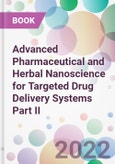Part II covers the following topics:
- Pharmaceutical nanosciences and their application in the delivery of various phytoconstituents
- Design of cosmeceutical drug delivery systems: the role of nanotechnology in cosmeceuticals
- Transfersomes: a novel vesicular transdermal delivery system
- Self-nano/micro emulsified drug delivery systems
- Phytosomes
- The role of nanomedicines in ocular drug delivery systems
- Colloidosomes as an efficient novel drug delivery system: an update
- Herbal nanoscience: challenges and regulatory perspectives
- Vitamins based nanomedicine approach
- Dendrimers: a versatile nanoplatform for advanced targeting and bioactive(s) delivery
- Targeted drug delivery systems for cells and cell organelles
- Liposomes for herbal drug delivery
- AI in pharmacy, herbal medicine and drug delivery: sci-fi or reality?
Table of Contents
Chapter 1 Pharmaceutical Nanosciences and Their Application in the Delivery of Various Phytoconstituents- Retno Widyowati and Andang Miatmoko Introduction
- Phytoconstituents in Herbal Medicine
- Phenolic
- Terpenoid
- Alkaloid
- Anthraquinone
- Nanotech for the Delivery of Different Phytoconstituents
- Liposome
- Microemulsion
- Solid Lipid Nanoparticles and Nanostructured Lipid Carriers
- Inorganic Nanoparticles
- Liquid Crystalline Systems
- Polymer Nanoparticles
- Dendrimers
- Therapeutical Application
- Cancer
- Rheumatoid
- Nutraceutical Delivery
- Conclusion
- Consent for Publication
- Conflict of Interest
- Acknowledgements
- References
- Merits of Nanocosmeceuticals
- Demerits of Nano Cosmeceuticals
- Novel Nanocarriers in Cosmeceuticals
- Niosomes
- Liposomes
- Nanocapsule
- Lipid Nanoparticles and Lipid Nano-Carriers (Sln and Nlc)
- Nanogold and Nanosilver
- Nanoemulsions
- Nano Sphere
- Cubosomes
- Major Nanocosmeceutical Class
- Skincare
- Haircare
- Lip Care
- Nail Care
- Nanotechnology in Herbal Drugs- Nanophytomedicine
- Nanocurcumin
- Green Nanotechnology (Cumin- Mediated Gold Nanoparticle)
- Ayurvedic Bhasma
- Aloe Vera Extract in Nanoparticles
- Emerging Challenges and Potential Solutions
- Cellular Toxicity of Zinc Oxide and Titanium Dioxide Nanoparticles
- Occupational Risks of Nanoparticles
- Potential Solutions
- Physical-Chemical Properties
- Mathematical Modelling
- Microscopic Techniques
- In Vitro Methods
- Future Prospect of Nanotechnology in Nano Cosmeceuticals
- Conclusion
- Consent for Publication
- Conflict of Interest
- Acknowledgements
- References
- Nagaraja Sreeharsha and Santosh Fattepur Introduction
- Advantages and Disadvantages
- Composition and Its Mechanism
- Transfersomes Penetration Mechanism
- Application of Transfersomes as the Transdermal Delivery System
- Delivery of Antioxidant
- Delivery of Anticancer Drug
- Delivery of Corticosteroids
- Delivery of Anti-Inflammatory Drugs
- Delivery of Insulin
- Delivery of Protein and Peptide
- Delivery of Interferon
- Delivery of Anesthetics
- Delivery of NSAIDs
- Delivery of Herbal Drug
- Regulatory Aspects
- Limitation of Transfersomes
- Future Perspective
- Conclusion
- Consent for Publication
- Conflict of Interest
- Acknowledgements
- References
- Vishal Trivedi and Jiyauddin Khan Introduction
- Herbal Medicine is a Novel Drug Delivery System
- Herbal Nanomedicines of Snedds and Smedds
- Self Emulsification Process
- Self-Nano Emulsifying Drug Delivery System (Snedds)
- Self-Micro Emulsifying Drug Delivery System (Smedds)
- Ingredients Required for the Formation of Self-Emulsification Drug Delivery System
- Excipients
- Surfactants
- Co-Surfactant
- Important of Sedds
- Mechanism of Sedds
- Dosage Forms from Sedds
- Dry Emulsions
- Sustained and Controlled-Release Tablets
- Self-Emulsifying Suppositories
- Implants of Self-Emulsifying
- Drug Properties and Characterization of Sedds
- For the Characterisation of Sedds
- Bioavailability Enhancement of Drugs by Sedds
- Snedds and Smedds Improved Dissolution Rate and Bioavailability of Poorly Soluble Drug
- P-Glycoprotein Inhibition
- Snedds and Smedds Drug Delivery System for Improving the Bioavailability/Lymphatic Uptake/Liver Uptake/ Peptide
- Advantages of Self-Emulsifying Drug Delivery
- Disadvantages of Self-Emulsifying Drug Delivery Systems
- Emerging Challenges and Potential Solutions of Snedds and Smedds
- Marketed Products of Sedds
- Future Prospects
- Conclusion
- Consent for Publication
- Conflict of Interest
- Acknowledgements
- References
- Phytosome/Herbosome/Pharmacosome/Liposome
- Phytosome or Herbosome
- Pharmacosomes
- Liposomes
- Phytosome Vs. Liposome
- Prerequisites for Phytosome/Herbosome/Liposome Formation
- Selection of Active Phytoconstituents or Standardized Extract
- Phospholipids
- Structure of Phospholipids
- Glycerophospholipids
- Sphingomyelins
- Phyto-Phospholipid Complex: Phytosome Technology
- Properties of Herbosomes (Phytophospholipid Complex)
- Physical Properties
- Chemical Properties
- Biological Properties
- Merits of Phytophospholipid Complexes (Herbosomes)
- Preparation of Herbosomes
- Phospholipids
- Solvents
- Phytoconstituents
- Methods of Preparation of Herbosomes
- Anti-Solvent Precipitation
- Solvent Evaporation Method
- Ether Injection Method
- Rotary Evaporation Method
- Novel Methods for Herbosomes Preparation
- Dosage Forms of Herbosomes
- Capsules
- Hard Gelatin Capsule
- Soft Gelatin Capsule
- Tablets
- Topical Preparations
- Optimization of Herbosomes
- Characterization of Herbosomes
- Partition Coefficient and Solubility
- Particle Size and Zeta Potential
- Yield
- Entrapment Efficiency
- Crystallinity and Polymorphism
- Stability of Vesicles
- Transition Temperature
- Measurement of Surface Tension Activity
- Drug Release
- Spectroscopic Confirmation of Herbosomes
- Fourier Transform Ir Spectroscopy
- Proton Nmr (1H Nmr)
- 13C Nmr
- Sem/Tem
- X-Ray Diffraction
- Marketed Herbosomes
- Limitations of Herbosomes
- Future Perspectives of Herbosomes
- Conclusion
- Consent of Publication
- Conflict of Interest
- Acknowledgements
- References
Author
- Swarnlata Saraf
- Ram Kumar Sahu
- Vivek Dave









